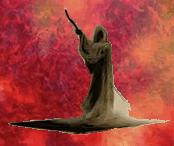
Halloween:
Sanhaim : Saints, Souls, Sinners
 |
|
|
|
|
| -by Dorian Borsella |
| Almost all religions, from time immemorial,
have posited the existence of some kind of afterlife, and some kind
of soul.. But where do these souls go? According to the mainstream Christian religions, they go to heaven or hell or purgatory or limbo. The more sedate religions—Episcopalians, for instance; God’s “frozen people” as they are sometimes called—I can say this since I have some identification with that branch of Christianity-- give a good talk about heaven. Very rarely have I heard anything about hell from that group. |
| Evangelicals are more egalitarian.
They talk a lot about hell. Some of them even go so far as to say that
unless you are “born again,” you are apt to go there. I don’t like to throw
out generalizations about any religious groups. But the Catholics do seem upbeat these days. In general, I believe they have more of an emphasis on salvation than damnation. Purgatory isn’t mentioned much. |
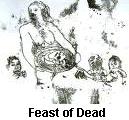 |
| Yet very recently I picked up a
newspaper and read of a conundrum that the current Pope was having about
limbo. Limbo according to Catholic doctrine is a place where all unbaptized
babies might go as well as all decent pagans who lived before the birth of
Christ. The church divines were pondering whether to remove the concept of
limbo from Papal Infallibility. But Pope Benedict XVI did not want to do it,
not just yet. So with various possibilities as to where one might go after death—and reincarnation is perhaps the most popular destination among the various peoples of the world—we jump the the topic of ghosts. |
 |
What is a ghost? There are various theories. Some people believe that ghosts are the residual energy left behind by an emotionally strong person or event. There has perhaps been a great trauma—or a long held grudge—or a person of powerful will. Such people when they die might leave behind their energy, electrical impulses. Modern ghost hunters take that approach. When they hunt down a ghost, they use electromagnetic detectors to pick up changes in energy fields. |
| Another theory is that, when someone dies and
has unresolved issues about their earthly existence, some part of that
person’s soul remains earthbound, watching the people they knew, checking in
at their favorite earthly haunt. The séances of Victorian times operated on this idea: that some of the dead had some message to give to the living. This wasn’t a case of “the medium is the message” but the medium, while in a trance, would be able to tap into some part of the dead person and receive a message to convey to the living, usually a close relative. |
 |
But no matter what the theory, Samhein (Sow-en), Halloween, is said to be the time when the veil separating the living world from the spirit world is at its very thinnest. Samhein, the New Year of the Celtic peoples and of today’s neopagans and Wiccans, is the time when you have the best chance to communicate with departed ones. |
|
And Samhein is also the time, if those departed ones want to communicate with us! |
| History of the Celts- with one cautionary: The Celts did not write anything of their own history. Their conquerors wrote it. The Celts are first mentioned in history by the Greek, Herodotus, circa 500 bce. They were in central France, in parts of Spain, stretching from eastern France to Bohemia. Moving north and west, they eventually reach Britain. |
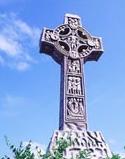 |
The Celts were very conscious of the spirit realm. Incurring so many invasions of other peoples into their realm, they felt they could gain favor with their over 300 gods by 1. fighting off these invaders and by 2. imitating their gods and making sacrifices to them. The sacrifices were USUALLY non-human. Of their holidays, the two huge ones were Halloween (Samhain) (Night of Oct. 31- Nov. l) and Beltaine, April 30 – May 1. Both were large fire holidays. Huge bonfires were built to represent the sun. Bonfire is “bone fire,” a fire of the bones of sacrificed animals. Circa the year 1600 c.e., bones of the “human animal” were usually excluded from these bone fires |
|
The sun, the fires, were crucial because the Celts had a staunch belief in
the powers of the darkness. On Samhain, the dead might literally rise from
their graves, trying to find the homes where they once lived. And if your
relatives could come back—The Irish, showing their usual hospitality, would
put out a spirit plate of food for their own dead—so could all kinds of
other spirits come back—benign or evil. Formerly human or never human;
rather -- demonic forces of darkness. |
 |
Trick
or Treat: We have two choices as to how trick-or-treat began. Some say
that these frightened villagers sought to placate the ghouls by offering
them gifts of nuts, fruit, or later a major meal. Other scholars aver that
trick- or- treating originated with the early Christians, with their
centuries-old custom called “Souling.” On or around November 1, the eventual “All Hallows Day” or “All Saints Day”, and the following day, “All Souls Day,” Christians would walk from village to village asking for "soul |
|
cakes,” just little cakes or pieces of currant bread. In exchange, prayers
would be offered for the dead relatives of those who gave these “soul cakes”
so that these souls could more quickly get into heaven. Later the Church
sold indulgences for the same purpose. |
|
How different is this from All Souls Day now as practiced in a strict Catholic church or an Anglo-Catholic church? Envelopes are given out. They still request you to fill them with dough, but not the kind that rises in an oven. On the back of the envelope, with your contribution included, you list the names of the dead that you want prayed for in a special All Souls Day Mass on November 2. |
|
(This is an aside, but strikes one as curious: among many groups who lived in the far north of the North American continent, in the ice country nearing the arctic circle, people were not permitted to die in their huts or igloos, i.e. could not die in their own homes! If they did…perhaps a sudden M. I…. this would contaminate the residence and it would have to be destroyed afterward. We’ll save that for another lecture). |
|
|
The Celtic priests, the Druids, wanted to placate their gods; they wanted to celebrate the sun. I often read “The people wanted to make sure the sun returned after the winter solstice,” but I personally have trouble believing that, after awhile at least, the people were that ignorant about the sun’s returning. The Celts knew exactly when and where the sun would return, as is evidenced by the setup of Stonehenge. However, it never hurts to offer a few sacrifices for these important matters. |
|
The word “Halloween” – all Hallows Eve—was not known until much later
when The Catholic Church had pushed into Celtic lands. During the 8th
century, the church moved their holiday of “All Hallows” to November 1, to
try to be accommodating to the peoples they had conquered and to try to
bridge the Celtics into Christianity. “All Hallows” is a commemoration of
all the saints that had no specific day of remembrance. The night before,
“All Hallows Eve,” became Halloween. |
 |
The Irish had one very spooky character, the Dullahan. He was a black-robed horseman. Without a head! The Dullahan did carry the head with him. It glowed, serving as a lantern.The head seemed to have the constituency of a huge hunk of rotting cheese. By holding this head up, the Dullahan could see for miles. The whip for the horse was a human backbone.. If you witness the Dullahan riding, you might be struck blind in one eye. This Dullahan rode around midnight on certain Irish festivals. When he stopped riding, a mortal would die. The Dullahan was a morph from the Celtic Black Crom, who stemmed back |
| 1500 years, demanding sacrifices of a head. When the Christians arrived, they frowned on this practice |
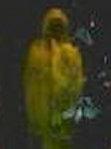 |
The Irish also had the banchee, a spirit woman who prowled around at
night, emitting eerie moans and wails. She had the three guises of womanhood
which modern Wiccans recognize: the young woman, the mature woman at the
height of her sexual powers, and the old crone. The banchee’s eyes were red
since she was constantly weeping. She was a harbinger of a death. |
|
Halloween and witches: Witches were always associated with Halloween.
As areas were getting Christianized, witches usually kept their belief in
the Old Religion.Christians had to look no further than the bible to
demonize them: |
|
Witches were thought to have all sorts of powers: they could make people or
farm animals infertile, they were thought to have a compact with Satan. They
were persecuted throughout the ages, sometimes by the Church and sometimes
by civil authorities, who were not so civil. But in 1486 there was published
a document called “Malleus Malefictorum." Malleus Maleficorum was a highly significant factor in shaping the ideas behind the witch persecutions in the 1500’s and thereafter. The Malleus Maleficarum was compiled by two Dominican inquisitors, Heinrich Kramer and Jacob Sprenger, who |
|
|
claimed in the book that they had been empowered by Pope Innocent VIII to
prosecute witches throughout Germany via a Papal decree of December 5,
1484. Shortly after that, the Church actually banned the book but that did
not stop subsequent action. |
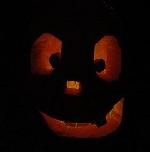 |
Halloween in England: In England the day of fires became November 5th (Bonfire Night), the anniversary of the Gunpowder plot of 1605, but its closeness to Hallowe'en is more than a coincidence. Hallowe'en and Bonfire Night have a common origin they both originated from pagan times, when the evil spirits of darkness had to be driven away with noise and fire. In the actual Guy Fawlkes incident, The Gunpowder plot was conceived by a man named Robert Catesby. . Catesby was a Catholic whose plan was to blow up Parliament during its opening ceremony on 5th November 1605, when the king. James I, would be present in the Palace of Westminster. With James I dead, Catesby would |
|
organize a Catholic uprising in the
Midlands, capture either the young Prince Charles or Princess
Elizabeth or both, and place one of them on the throne. |